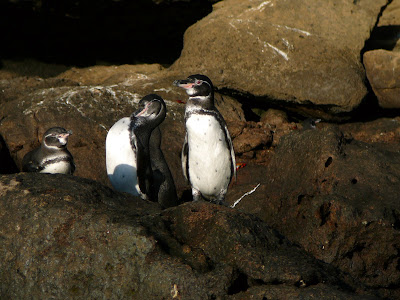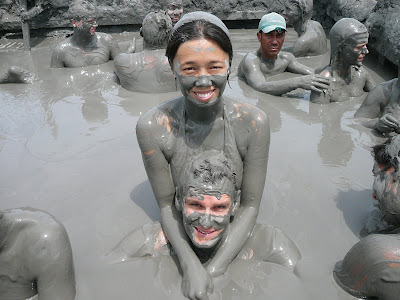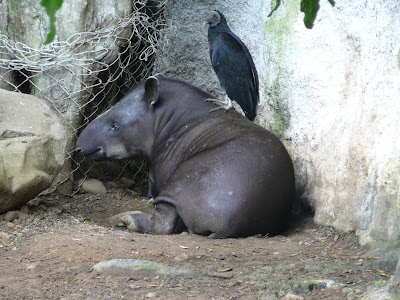Near Otavalo there are a few nearby lakes, one of which is Laguna Cuicocha, a crater lake on the side of Volcano Cotacachi. There is a 14 km walk around the crater that traverses paramo (high altitude grassland) and a few stands of pines with amazing views.
Quito, the capital, is at 2800 metres and the second highest capital city in the world after La Paz in Bolivia. We stayed for US$6.50 each in a clean place including breakfast.
Not wanting to visit the usual tourists' sites, we visited the botanical garden and the orchid greenhouses (one warm, one cool). One in every 4 plants in Ecuador is an orchid. Here are a few...

South of Quito is a small town called Baños (baths) known for its hot springs. It lies on the Andes but there is a bike ride on a road that descends about 1500m into the Amazon basin. It follows a river with cliffs on each side and spectacular waterfalls. The vegetation along the way changes from cloud forest to tropical forest with palms and banana trees. An off-track detour had us hauling the bikes over trees felled by landslides. Near the end there was a fried fish stall with a view over a wide floodplain that drains into the Amazon river. To return you just get on a bus heading uphill.
We decided at the last minute to go to the Galapagos Islands, which involves taking a boat for a few days with a prearranged itinerary for most people. The islands themselves are desolate, covered with dry, dead looking vegetation and cacti. The absence of land predators has allowed giant tortoises and land iguanas to grow to enormous sizes and sea birds to nest on the ground. The cold currents means a lot of food for penguins and sea lions. The water was about 18 degrees celcius so we needed wetsuits on the equator!
We flew from Guayaquil to Baltra Island and spent a night in the main town of Puerto Ayora on Santa Cruz island. The tour started that afternoon and led us to a beach with marine iguanas lazing on the rocks.
The next day we visited the Charles Darwin Research Centre, where giant tortoises are bred. The eggs are taken from nearby islands and hatched here. The babies are protected from predators for four years before being released back to their islands. From the centre we travelled by bus to a farm to see the tortoises in the wild.
We boarded our boat that afternoon and motored overnight to a new island with distinctive red sand beaches and friendly sea lions.
We visited two more islands over the next two days and saw more friendly and interesting animals.
 Blue Footed Boobys doing a mating dance
Blue Footed Boobys doing a mating danceThe most exciting part of the trip was getting engaged! We had spent the day swimming with penguins, iguanas and sea lions and climbed a hill on the island to watch the sunset. After a beautiful sunset over the twin bays below, Roger waited until everyone else had left before asking Luisa to marry him. Of course, she said yes!
In great spirits, we travelled back to Guayaquil in Ecuador and caught a bus into the mountains, to a town called Cuenca. From Cuenca it is a day trip to Cajas National Park which sits at about 4000m and is full of lakes, marshes and a maze of confusing walking trails. We tried to climb a mountain but lost the trail, so walked for a few hours through many lakes, stopping just before the afternoon rain.
 Alpaquitas, El Cajas National Park
Alpaquitas, El Cajas National Park Cajas
CajasSouth of Cuenca is a long bus ride to unremarkable Loja and the chilled and slightly touristy town of Vilcabamba. This was a great place to spend a couple of days with many walking and horse riding options through the hills.
Our route from there headed south-west down to the deserts of northern Peru.
Our route from there headed south-west down to the deserts of northern Peru.



































